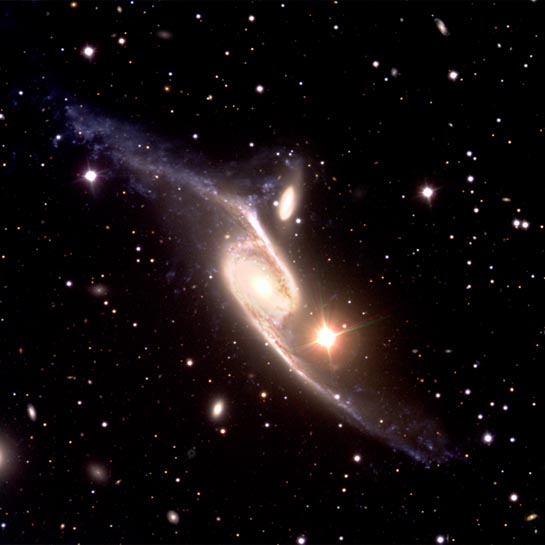
Interacting Galaxy
RA 20h 16m 56.58s Dec -70° 46' 6.10"
Pavo
200 million light years
12
6.0 x 1.7 arcmin
6.83 x 6.83 arcminutes
North is 20.0° right of vertical
ESO
April 30, 1999
Related images: G9924 G0912 G1437 2014 image: NGC 6872
ABOUT THIS IMAGE:
This is a three-color composite reproduced from one blue (B), one green-yellow (V) and one red (R) exposure, obtained with FORS1 at ANTU in the morning of March 29, 1999. The field size is 6.8 x 6.8 arcmin.
It shows the spectacular barred spiral galaxy NGC 6872 that is shaped like an "integral sign". It is of type SBb and is accompanied by a smaller, interacting galaxy, IC 4970 of type S0 (just above the center). The bright object to the lower right of the galaxies is a star in the Milky Way whose image has been strongly overexposed and exhibits multiple optical reflections in the telescope and instrument. There are also many other, fainter and more distant galaxies of many different forms in the field.
The upper left spiral arm of NGC 6872 is significantly disturbed and is populated by a plethora of bluish objects, many of which are star-forming regions. This may have been be caused by a recent passage of IC 4970 through it.
This
interesting system is located in the southern constellation Pavo (The
Peacock). It is comparatively distant, almost 300 million light-years
away. It extends over more than 7 arcmin in the sky and its real size
from tip to tip is nearly 750,000 light-years. It is in fact one of the
largest known, barred spiral galaxies. In order to image all of this extraordinary
object within the available field of the FORS1 camera, the instrument
was rotated so that the galaxy extends along the diagonal. For this reason,
the orientation is such that North is to the upper right and East is to
the upper left.